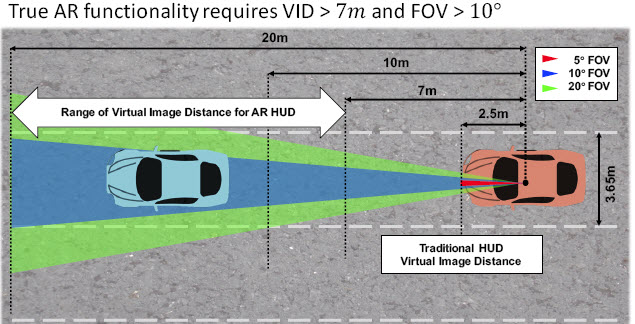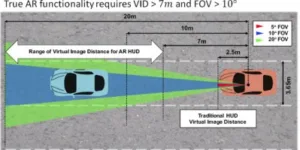
Sam Martin is from TI where he works on DLP for automotive HUDs. TI has made three generations of prototype HUDs to better understand the requirements and help its customers. The field of view (FOV) is 10º wide by 4º tall and the brightness of the display is 15K cd/m².
TI has learned a few things. Expanding the eyebox and FOV means a lot more power and increasing the virtual image distance (VID) can increase the sunlight loading.
Traditional HUDs create an image around the front bumper of the car and have around a 5º FOV. This is important because the driver keeps their eye on the road longer and accomodation time is a lot less. A limited FOV restricts the graphics that can be displayed and the use of AR. Ideally, the VID goes to 7 – 12 M and FOV goes up to 20 degrees or even more.

The eyebox is the area in which the image can be seen and there is typically a 140 x 60mm eyebox. Traditionally, you rotate the mirror to fit the driver. This is a problem if you want an AR application because it moves the whole optics and so you can’t map graphics onto objects. These things come at a cost, Martin said. TI’s target is 17k cd/m² with a 5º x 2º FOV and a 140 x 60 mm eyebox. Luminous power of 20 lumens is needed.
Increasing the size of the image for AR, for example to 10º x 4º needs four times the power. Double the eyebox and now you need 160 lumens, Martin said.
Sunlight loading is an issue. If you move the display surface (usually on a diffuser) nearer to the focal point you may have a problem, because sunlight gets focused onto the display – there could be a real thermal management issue.
Many HUD images disappear when you use polarising sunglasses – sometimes because the HUD image is polarised. The reflection angle from the windscreen is close to Brewster’s angle. One solution is to use a different windscreen coating. DLP can use non-polarised light so the issue is not a real problem.

